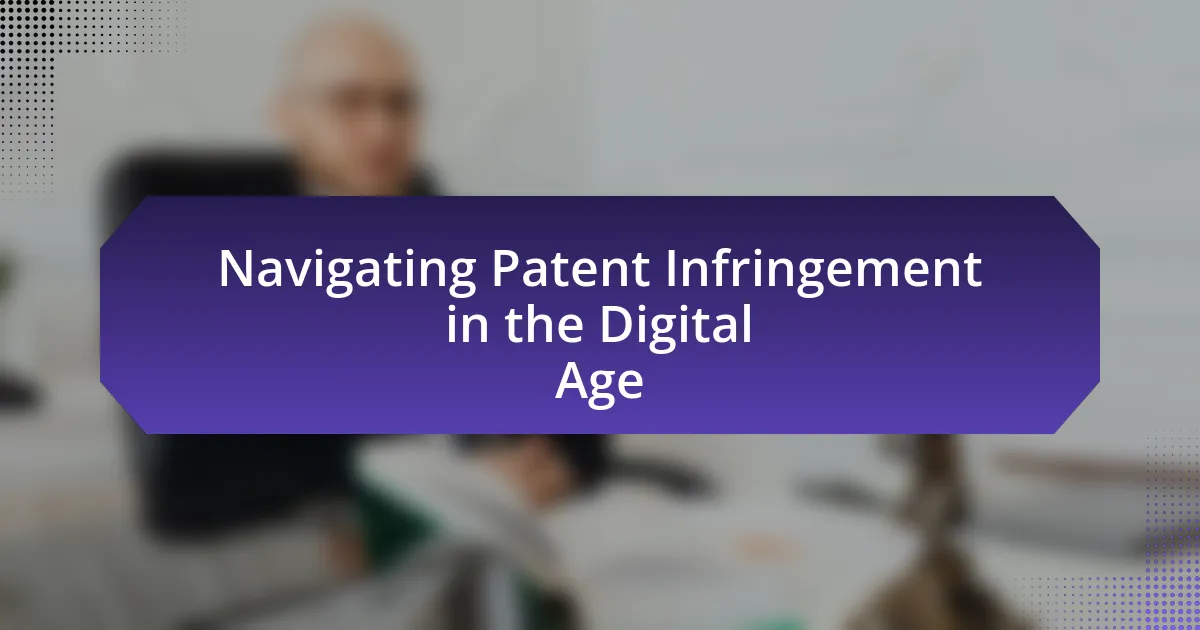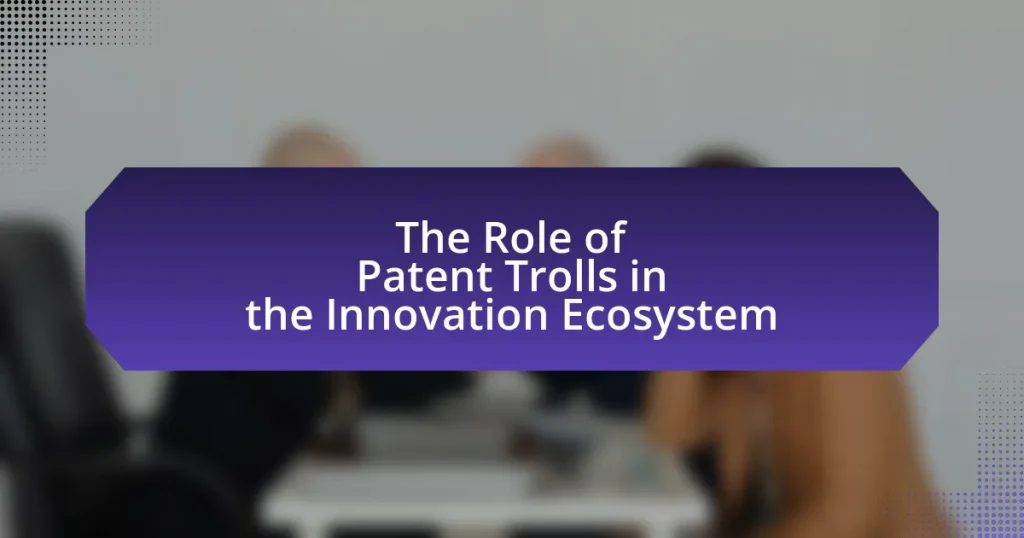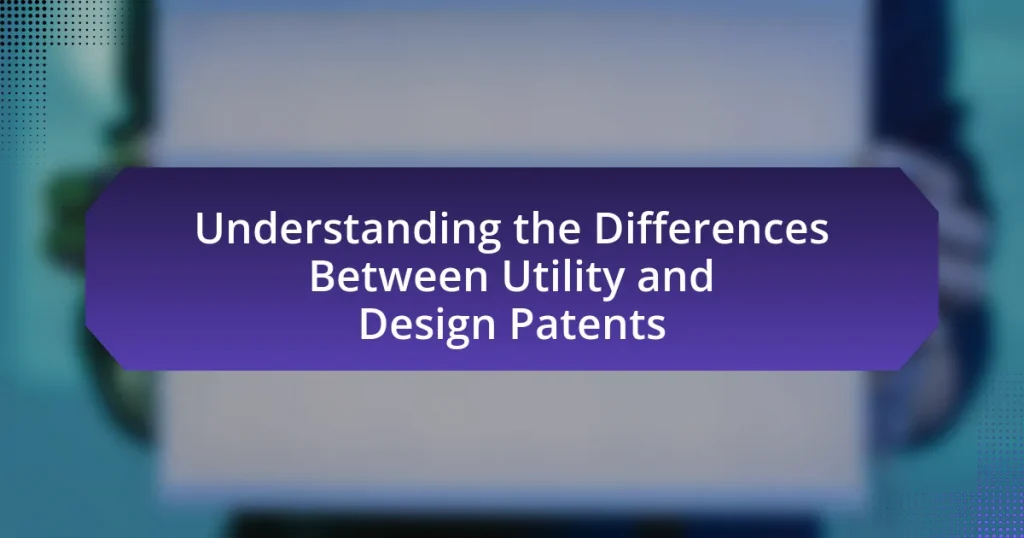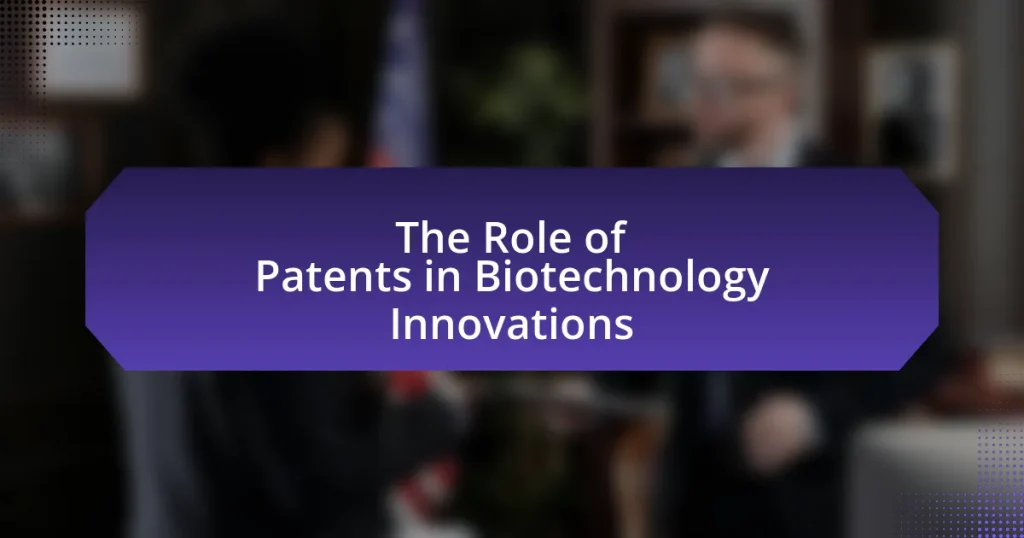Patent infringement in the digital age involves the unauthorized use, reproduction, or distribution of patented technologies in digital formats, including software and online services. The article examines how the digital landscape has transformed the nature of patent infringement, highlighting the ease of replication and the complexities of enforcement across jurisdictions. It outlines key characteristics of digital patent infringement, common types such as direct and contributory infringement, and the significant risks faced by digital companies. Additionally, the article emphasizes the importance of understanding patent laws for digital innovators and provides strategies for navigating patent issues, including conducting patent searches and engaging legal counsel.
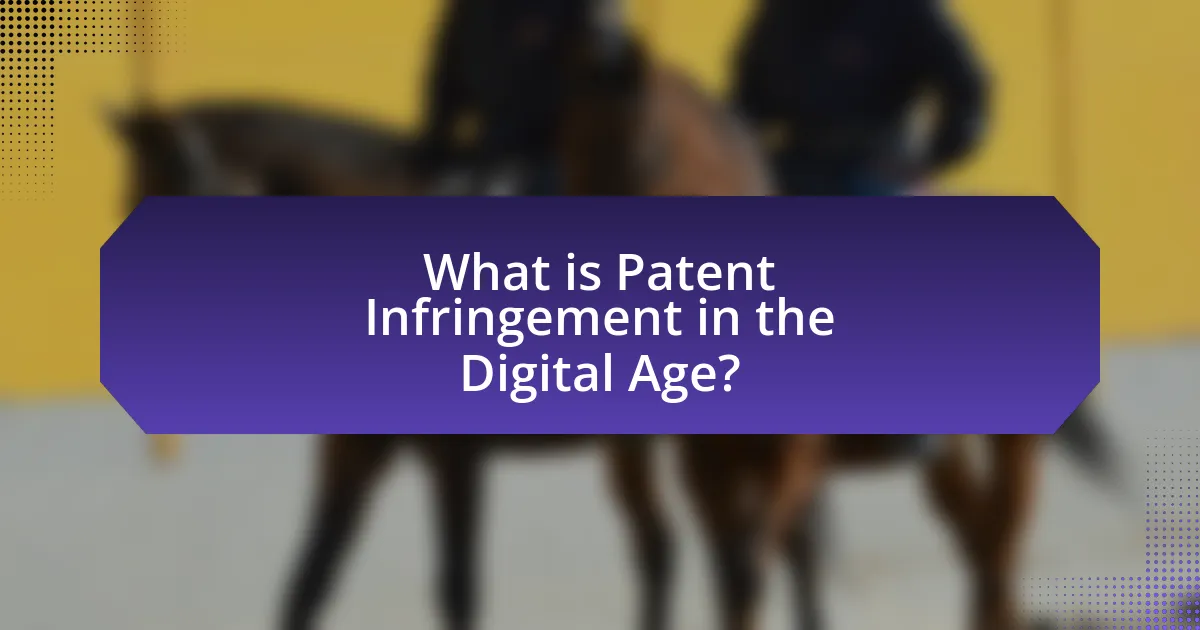
What is Patent Infringement in the Digital Age?
Patent infringement in the digital age refers to the unauthorized use, reproduction, or distribution of patented technology or inventions in digital formats or platforms. This includes software, online services, and digital content that may violate existing patents. The rise of the internet and digital technologies has complicated patent enforcement, as infringing activities can occur across jurisdictions and at a scale that was previously unimaginable. For instance, a 2020 report by the U.S. Patent and Trademark Office indicated that patent litigation related to software and digital technologies has increased significantly, highlighting the challenges faced by patent holders in protecting their intellectual property in a rapidly evolving digital landscape.
How has the digital landscape changed the nature of patent infringement?
The digital landscape has transformed patent infringement by increasing the ease of copying and distributing patented technologies. Digital platforms enable rapid dissemination of information and products, making it simpler for infringers to replicate patented inventions without detection. For instance, the rise of software and online services has led to a surge in cases involving digital patents, with a notable increase in litigation related to software patents, which rose by over 50% from 2010 to 2020. Additionally, the global nature of the internet complicates enforcement, as infringing parties can operate across jurisdictions, making it challenging for patent holders to pursue legal action effectively.
What are the key characteristics of digital patent infringement?
Digital patent infringement primarily involves unauthorized use, reproduction, or distribution of patented technology or processes in a digital environment. Key characteristics include the ease of replication and distribution of digital content, which can lead to widespread infringement with minimal effort. Additionally, digital patent infringement often occurs through online platforms, software applications, or digital services, making it challenging to identify and enforce patent rights. The rapid pace of technological advancement further complicates the landscape, as new digital innovations can quickly infringe existing patents without clear intent.
How do digital technologies complicate patent enforcement?
Digital technologies complicate patent enforcement by enabling rapid dissemination and replication of patented innovations, making it difficult to track and prove infringement. The ease of copying digital content, such as software and designs, often leads to widespread unauthorized use, which challenges traditional enforcement mechanisms that rely on clear identification of infringing products. Additionally, the global nature of the internet complicates jurisdictional issues, as patents are territorial and enforcement may require navigating multiple legal systems. This complexity is evidenced by the rise in litigation cases involving digital technologies, where companies struggle to protect their intellectual property rights effectively against infringers operating across borders.
Why is understanding patent infringement crucial for digital innovators?
Understanding patent infringement is crucial for digital innovators because it helps them avoid legal disputes and financial losses. Digital innovators often develop technologies that may inadvertently infringe on existing patents, leading to costly litigation or the need to pay licensing fees. For instance, in 2020, patent litigation in the technology sector reached over $3 billion, highlighting the financial risks associated with infringement. By comprehensively understanding patent laws and conducting thorough patent searches, innovators can protect their intellectual property and ensure their products do not violate others’ rights, thereby fostering a more sustainable and innovative digital landscape.
What risks do digital companies face regarding patent infringement?
Digital companies face significant risks regarding patent infringement, including costly litigation, potential damages, and reputational harm. The legal landscape is complex, with over 300,000 patent lawsuits filed in the United States between 2000 and 2020, highlighting the prevalence of disputes. Additionally, companies may incur substantial financial penalties, as damages awarded in patent cases can reach millions of dollars, impacting their financial stability. Furthermore, being involved in patent infringement cases can damage a company’s reputation, leading to loss of customer trust and market share.
How can knowledge of patent laws benefit digital entrepreneurs?
Knowledge of patent laws benefits digital entrepreneurs by enabling them to protect their innovations and avoid infringement. Understanding patent laws allows entrepreneurs to secure exclusive rights to their inventions, which can enhance their competitive advantage in the market. For instance, a study by the U.S. Patent and Trademark Office indicates that companies with patents are more likely to attract investment and partnerships, as patents signal innovation and market potential. Additionally, knowledge of patent laws helps entrepreneurs navigate potential legal disputes, reducing the risk of costly litigation and ensuring compliance with existing patents. This strategic understanding ultimately fosters a more secure and innovative business environment.
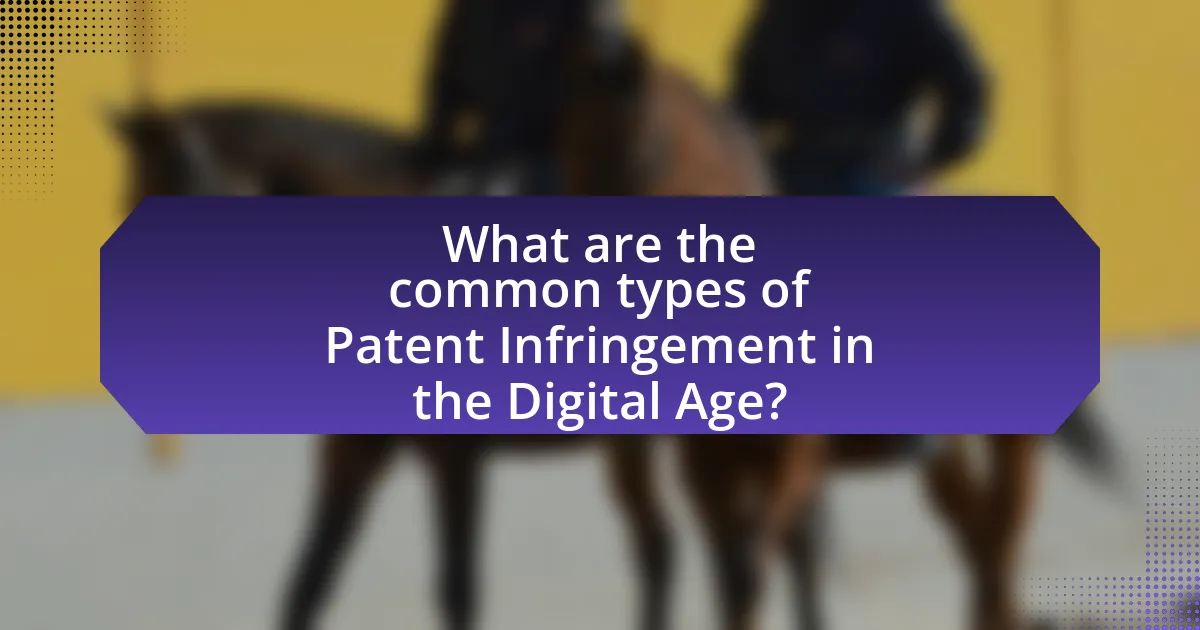
What are the common types of Patent Infringement in the Digital Age?
Common types of patent infringement in the digital age include direct infringement, indirect infringement, and contributory infringement. Direct infringement occurs when a party makes, uses, sells, or imports a patented invention without permission. Indirect infringement involves a party encouraging or aiding another to infringe a patent, while contributory infringement refers to supplying a component of a patented invention that is not suitable for substantial non-infringing use. These types of infringement are increasingly relevant as technology evolves, with cases often arising in software, digital media, and online services, reflecting the complexities of enforcing patent rights in a rapidly changing digital landscape.
What constitutes direct patent infringement in digital contexts?
Direct patent infringement in digital contexts occurs when a party makes, uses, sells, or offers to sell a patented invention without permission from the patent holder. This includes actions such as distributing software that incorporates patented technology, hosting a website that utilizes patented methods, or providing services that infringe on patented processes. The legal framework for determining infringement is based on the claims of the patent, which define the scope of the invention. Courts assess whether the accused product or service embodies each element of at least one claim of the patent. For instance, in the case of “Aro Manufacturing Co. v. Convertible Top Replacement Co.,” the U.S. Supreme Court emphasized that direct infringement requires a clear demonstration of the patented invention being utilized without authorization.
How can software applications infringe on existing patents?
Software applications can infringe on existing patents by incorporating patented algorithms, processes, or functionalities without authorization from the patent holder. When a software application uses a patented method or technology to perform its functions, it can be considered an infringement if the patented elements are essential to the application’s operation. For example, if a software application implements a specific data compression technique that is patented, it violates the patent rights of the holder. Legal precedents, such as the case of Oracle America, Inc. v. Google Inc., illustrate how software companies can face litigation for using patented technologies without permission, reinforcing the importance of conducting thorough patent searches and obtaining licenses when necessary.
What role do online platforms play in facilitating patent infringement?
Online platforms significantly facilitate patent infringement by providing a space for the distribution and sale of infringing products without adequate oversight. These platforms, such as e-commerce sites and social media, enable users to upload, share, and sell products that may violate existing patents, often without the patent holders’ knowledge. For instance, a study by the U.S. Patent and Trademark Office indicated that a substantial percentage of online sales involve counterfeit or infringing goods, highlighting the challenges patent owners face in monitoring and enforcing their rights in a digital marketplace.
What is contributory infringement and how does it apply online?
Contributory infringement occurs when a party knowingly contributes to another party’s infringement of a patent, typically by providing a product or service that facilitates the infringement. In the online context, this applies to platforms or services that enable users to infringe on patents, such as websites that host or distribute infringing content, or software that allows users to create or share infringing products. Courts have established that if a service provider has knowledge of the infringing activity and continues to provide the means for that infringement, they can be held liable for contributory infringement, as seen in cases like Grokster and the more recent decisions involving online marketplaces.
What examples illustrate contributory infringement in digital products?
Examples of contributory infringement in digital products include software platforms that facilitate the unauthorized distribution of copyrighted material, such as peer-to-peer file-sharing services. These platforms, like BitTorrent, enable users to share files without proper licensing, leading to infringement of copyright laws. Additionally, companies that produce devices designed primarily for the purpose of enabling the use of pirated software, such as modded gaming consoles, also illustrate contributory infringement. Courts have ruled against such entities, establishing that they can be held liable if they knowingly contribute to the infringement of others, as seen in the case of MGM Studios, Inc. v. Grokster, Ltd., where the Supreme Court found Grokster liable for contributory infringement due to its promotion of illegal file sharing.
How can companies mitigate risks of contributory infringement?
Companies can mitigate risks of contributory infringement by implementing robust compliance programs and conducting thorough due diligence on their products and services. These programs should include regular audits of supply chains to ensure that third-party components do not infringe on existing patents. Additionally, companies should provide training for employees on intellectual property laws and establish clear guidelines for product development that prioritize patent compliance. Research indicates that organizations with proactive intellectual property strategies are less likely to face infringement claims, as they can identify potential risks early and take corrective actions.

How can companies navigate Patent Infringement issues in the Digital Age?
Companies can navigate patent infringement issues in the digital age by implementing robust intellectual property strategies, including regular audits of their own and competitors’ patents, and utilizing technology to monitor potential infringements. For instance, employing patent analytics tools can help identify trends and potential risks associated with patent violations. Additionally, companies should engage in proactive licensing agreements and consider alternative dispute resolution methods to mitigate litigation costs. According to a report by the World Intellectual Property Organization, businesses that actively manage their patent portfolios are better positioned to avoid infringement disputes and leverage their innovations effectively.
What strategies can businesses employ to avoid patent infringement?
Businesses can avoid patent infringement by conducting thorough patent searches and implementing robust intellectual property management practices. Conducting patent searches allows businesses to identify existing patents that may overlap with their products or services, thereby informing design and development processes. Additionally, businesses should invest in training employees on patent laws and the importance of respecting intellectual property rights, which can help foster a culture of compliance. Regularly consulting with legal experts specializing in intellectual property can also provide guidance on navigating complex patent landscapes. These strategies are supported by the fact that companies that proactively manage their intellectual property are less likely to face costly litigation and can innovate more freely within legal boundaries.
How can conducting patent searches help in avoiding infringement?
Conducting patent searches helps in avoiding infringement by identifying existing patents that may cover similar inventions or technologies. By reviewing these patents, individuals and companies can assess the scope of protection granted to others and modify their own innovations to steer clear of potential legal conflicts. For instance, a study by the United States Patent and Trademark Office indicates that thorough patent searches can reduce the risk of litigation by up to 30%, as they allow inventors to design around existing patents or seek licensing agreements. This proactive approach not only minimizes the likelihood of infringement but also fosters innovation by encouraging the development of unique solutions.
What role does legal counsel play in navigating patent issues?
Legal counsel plays a critical role in navigating patent issues by providing expert guidance on patent law, ensuring compliance, and protecting intellectual property rights. They assist clients in conducting patent searches to identify existing patents, evaluate the patentability of inventions, and draft patent applications that meet legal requirements. Furthermore, legal counsel represents clients in patent litigation, helping to resolve disputes and defend against infringement claims. Their expertise is essential in interpreting complex patent laws and regulations, which can vary significantly across jurisdictions, thereby minimizing legal risks and enhancing the strategic management of patent portfolios.
How can companies respond if accused of patent infringement?
Companies can respond to accusations of patent infringement by conducting a thorough analysis of the claims and assessing the validity of the patent in question. This involves reviewing the patent’s scope, prior art, and potential defenses such as non-infringement or invalidity. For instance, a company may argue that its product does not fall within the claims of the patent or that the patent itself is not enforceable due to prior existing technology. Additionally, companies can seek legal counsel to explore options for negotiation, settlement, or litigation, as seen in cases like Apple v. Samsung, where both parties engaged in extensive legal battles over patent rights. Engaging in proactive communication with the accusing party can also lead to resolution without escalating to court.
What are the steps to take when facing a patent infringement lawsuit?
When facing a patent infringement lawsuit, the first step is to consult with a qualified patent attorney to assess the situation and develop a legal strategy. This is crucial because an attorney can provide expert guidance on the specifics of patent law and the implications of the lawsuit.
Next, gather all relevant documentation, including the patent in question, any correspondence related to the infringement claim, and evidence of your product’s development and use. This documentation is essential for building a defense or negotiating a settlement.
After that, evaluate the validity of the patent being asserted against you. This involves researching the patent’s claims and determining if they are enforceable or if there are grounds for invalidity, such as prior art that predates the patent.
Following this, consider your options for response, which may include filing an answer to the complaint, seeking a settlement, or pursuing a counterclaim if applicable. Each option has different implications for your business and should be carefully weighed.
Finally, prepare for potential litigation by developing a comprehensive defense strategy, which may involve expert witnesses, technical analyses, and a thorough understanding of the legal landscape surrounding the patent. Engaging in discovery and pre-trial motions will also be necessary to strengthen your position.
These steps are critical in effectively navigating a patent infringement lawsuit and protecting your interests in the digital age.
How can settlements or licensing agreements resolve disputes?
Settlements or licensing agreements can resolve disputes by providing mutually agreed-upon terms that allow parties to avoid lengthy litigation. These agreements often include financial compensation, usage rights, or modifications to business practices, which can satisfy the interests of both parties involved in a dispute. For instance, in patent infringement cases, a licensing agreement can enable the alleged infringer to legally use the patented technology while compensating the patent holder, thus preventing further legal action. This approach not only saves time and resources but also fosters ongoing business relationships, as evidenced by numerous cases in the technology sector where companies have successfully negotiated settlements to avoid costly court battles.
What best practices should companies adopt regarding patents in the digital space?
Companies should adopt a proactive approach to patent management in the digital space by conducting regular patent audits and ensuring comprehensive documentation of their innovations. Regular audits help identify existing patents that may overlap with new developments, reducing the risk of infringement. Comprehensive documentation, including detailed records of the development process, supports claims of originality and can be crucial in legal disputes. Additionally, companies should invest in employee training on intellectual property rights to foster a culture of innovation while respecting existing patents. This practice is supported by the fact that organizations with strong IP training programs are less likely to face infringement lawsuits, as highlighted in a study by the World Intellectual Property Organization.
How can companies stay updated on patent laws and regulations?
Companies can stay updated on patent laws and regulations by subscribing to legal databases, attending industry conferences, and following updates from patent offices. Legal databases like LexisNexis and Westlaw provide real-time updates on changes in patent law, while industry conferences often feature sessions on recent developments. Additionally, patent offices, such as the United States Patent and Trademark Office, regularly publish updates and guidelines that are crucial for compliance. These methods ensure that companies remain informed about the evolving landscape of patent laws, which is essential for navigating potential infringement issues effectively.
What resources are available for companies to educate themselves on patent issues?
Companies can educate themselves on patent issues through various resources, including the United States Patent and Trademark Office (USPTO) website, which offers comprehensive guides and educational materials on patent law and application processes. Additionally, organizations such as the World Intellectual Property Organization (WIPO) provide online courses and webinars focused on intellectual property rights, including patents. Legal firms specializing in intellectual property often publish articles, white papers, and host seminars that address current patent issues and best practices. Furthermore, industry associations frequently offer workshops and resources tailored to specific sectors, enhancing understanding of patent-related challenges and strategies.
